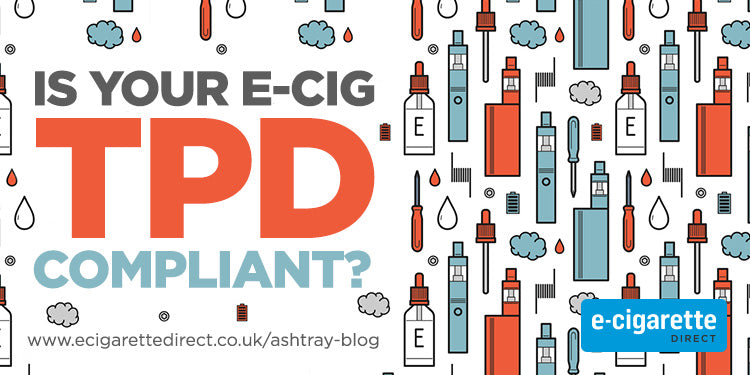
Is Your Vape TPD Compliant? Here's How To Find Out...
If you shop for vapes often, you’ll likely see the term ‘TPD compliant’.
As non-TPD (i.e. illegal) vapes can contain damaging substances, it’s well worth understanding what this term means, and how to ensure your vape is compliant.
So in this post, you’ll get a brief introduction to what TPD means, along with hints and tips to help you ensure that you are buying legal vapes.
- What does TPD compliant mean?
- At a glance
- What about vape batteries and mods?
- 10ml e-liquid limit
- 2ml tank/pod capacity
- 2% or 20mg/ml limit on nicotine levels
- Warning and information
- Does everyone comply with TPD regulations?
- Related posts
When your vape is TPD compliant, it means that it conforms with rules set out by article 21 of the EU Tobacco Products Directive II.
Despite Brexit, the rules set out in the regulations still apply, and vapes have to be TPD compliant to be legal.
The impact of the TPD brings both benefits (such as mandatory testing of e-liquid and devices) and inconveniences (such as limits on bottle size and tanks) for vapers. We’ll cover these in more detail below.
- Undergo emissions testing
- Not contain certain ingredients which may cause harm when inhaled
- Be in a bottle or pod no larger than 10ml
- Come with a warning leaflet (which may be on the inside of the bottle’s label)
- Have a nozzle at least 1 cm long, and emit no more than 20 drops a minute
- Have an ECID (European Community Identification Number) and be registered on the MHRA website
- Include a warning stating:
This product contains nicotine which is a highly addictive substance
Do note that TPD regulations do not apply to zero-nicotine products.
TPD-compliant devices, pods and tanks must:
- Contain a maximum of 2ml e-liquid
- Have an ECID and be registered on the MHRA website.
- Come with a warning label stating that:
This product contains nicotine which is a highly addictive substance.
As many pods and tanks don’t contain nicotine until they get in your hands, Trading Standards advise having a second warning that states:
The following warning applies when the product is used with e-liquids containing nicotine.
The coil in compliant tanks and pods must also undergo emissions testing.
- visit the e-cigarette page on the MHRA website
- scroll down to the Submitted Products heading
- click on the link saying: Submitted Products
This will download an Excel file, although it’s not always easy to find the exact e-liquid or supplier you are looking for.
The TPD does not apply to vape batteries and mods when sold without a pod, tank or e-liquid.
The maximum amount of nicotine allowed in a 10ml bottle of e-liquid is 20mg, which equates to 2% nicotine. This is much lower than the equivalent allowed in cigarettes.
There are now controls over what ingredients can be added to e-liquid. For example, prior to the introduction of the TPD, there was concern over the use of diacetyl in e-liquid. Ingredients of concern like diacetyl are now banned from use in e-liquid.
Before e-liquid or vape devices can be sold, they must undergo emissions testing. This involves using the device or e-liquid to produce vapour, and then testing that vapour for impurities like heavy metals or carbonyls.
This is one of the most positive elements of the TPD, as it can reassure vapers that legal vapes are much less harmful than tobacco cigarettes.
Some manufacturers go much further than the legal requirements, as demonstrated by the Vape Safety project.
Both e-liquid and vape devices must contain warning labels and information.
E-liquid information includes:
- A warning label and raised triangle
- Nicotine strength
- Bottle size
- Safety information
- Ingredients
The information is similar for disposable vapes. Here’s what a typical TPD-compliant disposable vape looks like:

Unfortunately not.
When I’ve been touring competitors, I’ve seen, and even bought, non-compliant vapes. Trading Standards data confirms this, estimating that a third of vapes sold are non-compliant.
While authorities have seized illegal vapes, the amount is likely to be a fraction of that actually sold.
To avoid buying an illegal vape, it’s best to buy from reputable retailers and learn how to identify the signs of an illegal device.
After all, the sort of seller deliberately flouting the law and selling illegal tanks and e-liquids is also the sort of seller who probably doesn’t care most about quality, safety or your health.